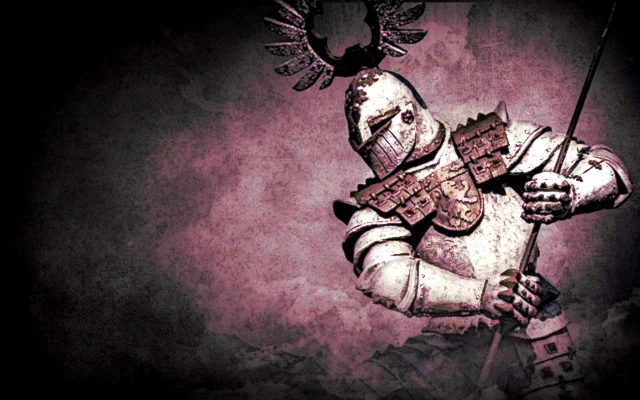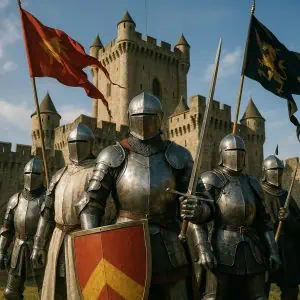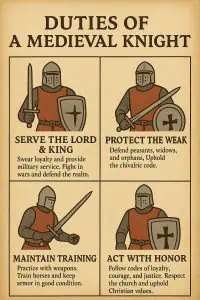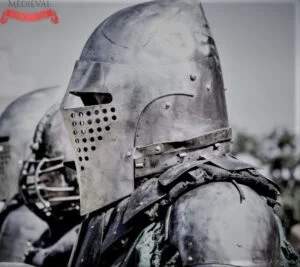The history of medieval knights spans centuries of warfare, social transformation, and evolving ideals. Emerging in the early Middle Ages, knights began as heavily armed cavalry serving feudal lords, but soon became central figures in the political and military fabric of Europe. Their rise to prominence was fueled by the need for skilled warriors during times of conflict, and their role expanded to include landholding, governance, and enforcing justice. Over time, the image of the knight was shaped not just by battlefield valor but also by the chivalric code, which demanded honor, piety, and loyalty. The legacy of knights continues to influence modern perceptions of courage and nobility.

It was during this later period when various orders of the knights were formed throughout Europe, particularly during the Crusades with the Muslims in the East. Thus the late medieval times are a high point in medieval knights’ history.

Medieval Knights in Ancient History
The concept of knighthood during medieval times also derives inspiration from the ancient world. A similar concept existed in ancient Rome and Greece where their status was higher than the ordinary citizens although lower than the senatorial class.

A certain amount of fortune was a prerequisite for becoming a knight and the status was forfeited if the required fortune could not be managed. Thus medieval knights’ history can trace its roots back to the ancient world.
Charles the Bald ‘Holy Roman Emperor’ is an important knight from this era.

Knights Early Medieval Period
Medieval knights’ history during the early medieval ages revolves around the Franks who conquered vast tracts of territory throughout Europe.
The Franks had large numbers of warriors who fought on horseback and gave rise to the whole concept of knighthood.

Also, during these times, Europe was fragmented into small parts ruled by local lords and they hired knights for their protection and for battles against other lords.
Knights History High Medieval Period
In medieval knights’ history, it was during the high medieval times that knighthood attained the social status of note.
This was the era when Crusades were fought and various orders of knights such as
- Knights Hospitaller
- Knights Templar
- Order of Saint Lazarus
- Teutonic Knights
and others took birth.
Rules and ceremonies of knighthood were also formed mainly during this age.

Knights History Late Medieval Period
Late medieval times are the most important era in medieval knights‘ history because knighthood became established at the beginning of this era and its decline began by the end of the same period.

Knights mainly hailed from nobility and their weapons were better and more expensive compared to the weapons of the common soldiers. The Code of Chivalry also developed and many knights were granted estates by kings and nobles.

Famous Knights
Many knights made their mark during the long medieval knight history. For instance, during the Crusades, Richard the Lionheart proved himself to be a great military leader and a worthy knight.
Another famous medieval knight was El Cid who fought against the Moors in Spain during the 11th century.


Other famous medieval knights include
- Alexander Nevsky
- Edward the Black Prince
- William Wallace



Knights History Summary
The history of Medieval knights has its roots in the ancient world but the actual phenomenon became popular during the middle and late medieval times.
Various factors were responsible for this rise of knighthood. Some of them were invasions of Vikings from the North and the Ottoman Empire from the East.

The concept continued to evolve throughout medieval times when it became customary for kings and lords to grant land and estates to knights in return for their protection.
Frequently Asked Questions about Medieval Knights History
When did medieval knights first emerge?
Medieval knights first emerged in the early Middle Ages, around the 9th and 10th centuries, evolving from mounted warriors who served local lords.
What roles did knights play in medieval society?
Knights served as military protectors, vassals, and symbols of chivalry and honor in both war and courtly life.
What was the code of chivalry?
The code of chivalry was a set of rules emphasizing honor, loyalty, courage, and protection of the weak that knights were expected to follow.
How were knights trained?
Boys began as pages around age 7, advanced to squires, and trained in combat, horsemanship, and etiquette before being knighted.
Did all knights own land?
Not all knights were landowners. Some were granted fiefs by their lords, while others served as professional warriors without land but maintained social prestige.
What weapons and armor did knights use?
Knights used swords, lances, maces, and daggers and wore chainmail or plate armor for protection in battle and tournaments.
What is the legacy of medieval knights?
The legacy of knights includes military strategy, chivalric ideals, and cultural influence that continue to inspire literature, films, and modern ceremonies.






